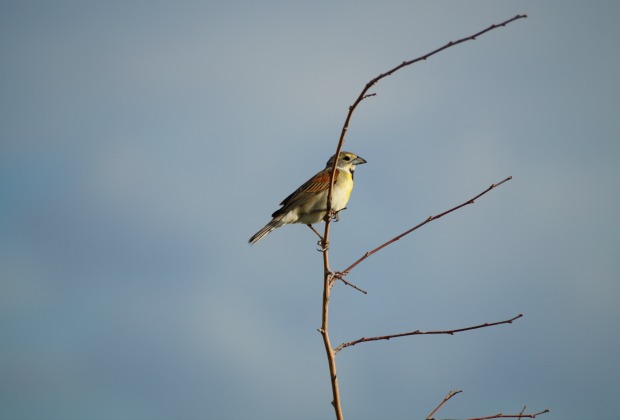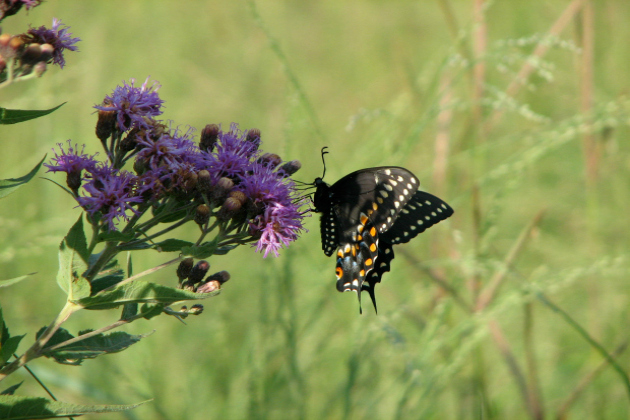Biodiversity of a Restored Tallgrass Prairie
Flora of Glacier Creek Preserve
More than 350 species of woody and herbaceous plants, 17 species of bryophytes, and 10 species of lichen have been identified at various locations throughout Glacier Creek Preserve, with most of the typical prairie species found in the original 1970's restoration.
Quantitative surveys find slopes and hilltops of the Tallgrass areas dominated by big bluestem (Andropogon gerardii) with little bluestem (Schizachyrium scoparium) and sideoats grama (Bouteloua curtipendula) being common. Lowland areas are predominantly big bluestem, reed canary grass (Phalaris arundinacea), and switchgrass (Panicum virgatum). Little bluestem and sideoats grama dominate the Mixed-Grass Prairie.
The common forbs include leadplant (Amorpha canescens), Canada and prairie goldenrod (Solidago canadensis and S. missouriensis), common milkweed (Asclepias syriaca), round-head bush-clover (Lespedeza capitata), grayhead prairie coneflower (Ratibida pinnata), and rosinweed (Silphium integrifolium).
Click here for the Glacier Creek Preserve plant species list
Click here for the Glacier Creek Preserve Bryophytes and Lichens species list

Fauna of Glacier Creek Preserve
In addition to a diverse flora, over 170 species of birds, amphibians, reptiles, and mammals have been observed in various locations throughout the Preserve. The most common breeding bird species include both residents, such as the red-tailed hawk (Buteo jamaicensis), great horned owl (Bubo virginianus), and mourning dove (Zenaida macroura), and migrants, such as the sedge wren (Cistothorus platensis), western meadowlark (Sturnella neglecta), red-winged blackbird (Agelaius phoeniceus), dickcissel (Spiza americana), and grasshopper sparrow (Ammodramus savannarum). The LeConte’s (Ammodramus leconteii) and Harris’ sparrows (Zonotrichia querula) and northern harrier (Circus cyaneus) are among less common migrants found at the preserve.
Among mammals of the prairie and woodland, the most common include the prairie and meadow voles (Microtus ochrogaster and M. pennsylvanicus), thirteen-lined ground squirrel (Spermophilus tridecemlineatus), North American deermouse (Peromyscus maniculatus), coyote (Canis latrans), red fox (Vulpes vulpes) and white-tailed deer (Odocoileus virginianus). The Plains Gartersnake (Thamnophis radix), Northern Prairie Skink (Plestiodon septentrionalis), and Woodhouse's Toad (Anaxyrus woodhousii) are among the most common herpetofauna in drier locations with frogs, such as Blanchard’s Cricket Frog (Acris blanchardi), the Plains Leopard Frog (Lithobates blairi), and the Boreal Chorus Frog (Pseudacris maculata) as well as the Western Foxsnake (Pantherophis ramspotti) and Common Gartersnake (Thamnophis sirtalis) found principally along Glacier Creek floodplain habitats.
A diverse invertebrate community of the restored prairie includes 56 butterfly species, which includes a large population of the regal fritillary (Speyeria idalis), a butterfly species of concern for the U.S. Fish and Wildlife Service. The monarch butterfly (Danaus plexippus) is commonly observed at the preserve. Over 200 moth species have been identified using lightsheeting at the preserve during the annual Night Life event at Glacier Creek Preserve. In addition to these mostly terrestrial invertebrates, other invertebrates are found in Glacier Creek itself, including dragonflies (Aeshna spp.), damselflies (Family: Coenagrionidae), and caddisflies (Family: Limnephilidae). In general, the overall diversity of fauna at Glacier Creek Preserve approximates that of local native prairie remnants indicative of a well-established diversity of habitats.
Check out the following Glacier Creek Preserve species lists:
